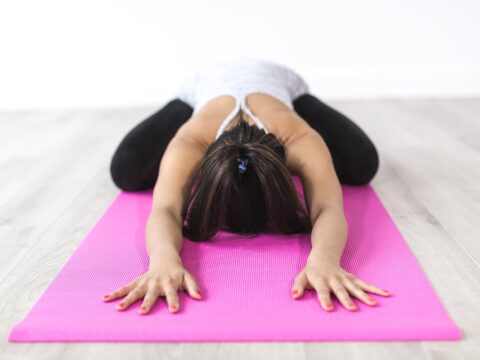What is Mindfulness Meditation? The term mindfulness refers to the ability to focus on the present moment and to be aware of your thoughts and surroundings. This state of mind allows you to not think about the past or the future, but to instead observe what is happening in the moment.
Why Should We Practice Mindfulness Meditation?
So many people don’t know that mindfulness is an integral part of yoga. When you’re doing yoga, you’re practicing mindfulness. It’s what helps you concentrate and become aware of your breath.
Now, I know that sounds kind of weird, but if you think about it, it makes sense. If you want to meditate, you need to focus on your breath. That’s because when you’re meditating, you’re actually practicing mindfulness.
And just like meditation, you can’t learn how to meditate unless you practice mindfulness first.
Think about how you would react if you tried to learn something that you had no idea how to do. If you went through all of the steps you needed to learn a new skill, you would probably end up frustrated and anxious.
And that’s exactly how you’d feel if you tried to learn something that you knew nothing about. If you don’t know how to do something, you won’t have any success learning it.
The same thing goes for meditation. If you try to meditate without practicing mindfulness first, you won’t be able to understand what it means to practice mindfulness.
Podcast
https://youtu.be/zIAAiBt0Ztw
Cultivating Mindfulness Practice In Our Daily Lives
Although it is difficult to find time to do a 20-30 minute mindfulness meditation, we can build micro-practices into our day to help us focus our attention on what is important.

Top 10 mindfulness activities you can practice throughout the day
By being mindful and present, you can appreciate the simple wonders life has to offer.
Practice gratitude
Focused + available = success Gratitude allows us to focus on the positive things in our lives, which makes us more available to create a positive future.
Perform breath-awareness meditation
The breath allows us to live in the present whenever we focus on it. Because it is so responsive to emotional reactions and stress, focusing on our breathing can tell us a lot about ourselves.
An example of how our breathing can be connected to our emotions is when we experience fear we may hold our breath. This happens because when we feel anxious, we may constrict our breathing.
Our relationship to breathing is a metaphor for how we relate to living. This is one of the reasons why focusing on our breath through mediation can be so useful and important.
To meditate effectively, it is important to have a relaxed, upright posture that allows the breath to flow freely. This posture embodies the quality of awareness that supports the meditation practice.
Slouching, instability, and other less-than-ideal postural attributes tend to reinforce qualities like sleepiness, inattention, irritation, and agitation, while a proper posture leads to a clear, relaxed awareness.
Do body scan meditation
Alpers argues that mindfulness is not just a mental exercise, but something that engages the body as well.
Looking closely at the sensations in our bodies, moment by moment, allows us to stay centered on the reality of our physical sensations in the present.
The body scan can help us understand the connection between the mind and body. We may notice that when we judge something or have an emotional reaction, our muscles tighten and we brace ourselves.
These are all part of the same process in the mind, which includes thoughts, emotions, physical reactions, and sensations in the body.
The body scan allows us to let go of both our emotions and our physical self simultaneously.
Apply mindful movement meditation
First, you’ll need some props, so go ahead and grab a comfortable mat, a blanket or towel, a pillow or two, and some headphones or earbuds. These items are very important, because they’ll make meditation much easier and more effective.
Second, you’ll need a timer, or a watch that will buzz every few minutes. The idea is to take 10 minutes out of your day for meditation, and to practice every day.
Third, you’ll need some space to meditate. In fact, you’ll need a lot of space, so grab a spot that’s close to an exit, and preferably one that faces north or south, because that’s when the sun is strongest.
Do sitting meditation
When you hear the word “meditation,” you probably think of a person sitting in the lotus position with their spine straight, hands in their lap, eyes closed, and a slight smile on their face. And you would be right to do so!
An upright spine helps you stay alert, while sitting with your legs crossed and bottom on the floor provides a solid, stable base for remaining still.
The sitting posture helps in observing the mind-body process. It allows for clearer observation by remaining still. This stillness helps in observing the changing landscape of awareness. Various sensations, perceptions, thoughts, emotions, and moods are experienced.
These experiences come from the mind and body. They can be seen more easily when the individual is not moving.
In this way, the sitting posture is like a transparent container within which the movements of the mind-body process become clear.
Sitting meditation practices involve systematic focus. They focus on different objects. These objects include breath sensations and other body sensations. They also include the body as a whole field of sensations.
Hearing and awareness of discreet sounds are also focused on. The soundscape as a whole is another object of focus. Awareness of thinking, emotion, moods, and mind states is also included. The final object of focus is the present moment as a whole.
According to Alper, the sitting posture is the best way to meditate because it allows you to be aware of everything around you without having to make any decisions.

Execute walking meditation
Although walking is something we do every day, we rarely take the time to fully experience it. Most often, we are focused on where we are going and what we will do when we get there. However, the moments when we first learn to walk are usually full of triumph and exhilaration.
Walking meditation is the act of being fully aware of the act of walking and all the sensations that come with it. It is the opposite of “sleepwalking through walking” which is when someone is not fully present and not noticing the act of walking or the sensations that come with it.
We often lose focus when transitioning between activities in life. Moving meditations, like those mentioned above, as well as mindful walking, can help us become more mindful and sustain our focus when we’re moving through life from one activity to the next.
Focus on loving-kindness and compassion
Loving-kindness meditation focuses on developing an accepting attitude towards all experiences, regardless of their content. This is typically done by focusing on a particular object, repeating certain phrases, and visualizing certain images.
Loving-kindness and compassion can help us to see ourselves in a different light, and to start feeling better about ourselves, about the world, and about everything else.
If you want to learn more about loving-kindness and compassion, check out the links below!
And remember, we can all start to practice loving-kindness and compassion in the smallest moments of everyday.
Radical acceptance provides the clearest perception in each moment because it is not distorted by judgment, aversion, or grasping. Clear perception in each moment allows for the most skillful response in the next moment, which decreases the likelihood of creating suffering. In this way, radical acceptance is actually very practical.
If you find yourself experiencing any of the above mentioned challenges during mindfulness meditation, know that it is still possible to find peace and relief through the practice of loving-kindness.
Practice active listening
If you find yourself only half-listening to the people you talk to, try practicing active listening instead. This involves really paying attention to the person, with your ears, heart, and intuition. You may find that the quality of your conversations improves.
Fire up your five senses
Bringing your attention to the present moment is one of the simplest ways to stay mindful. Stop what you are doing for a second and take note of your surroundings. What noises do you hear? What scents do you smell? What are others around you doing? Pay attention to where you are and what you’re doing through your five senses for a few moments.
Check in with your body
The body does a lot of things automatically, like breathing and heartbeat, but it also sends messages to us through sensations. Paying attention to these sensations can help us take care of our bodies better. It can also help us focus on the present moment.
I find it easier to make mindfulness part of my daily activities so I can train my mind to stay more positive, feel happier, and be in charge of what I choose to attract to myself by staying in the here and now.
What are the benefits of mindful meditation?
Yoga, the practice of breathing, is one of the oldest forms of meditation around. But did you know that there are many different forms of meditation? In fact, there are millions of people worldwide that practice some form of meditation every day.
But most people aren’t familiar with the various types of meditation that exist, so it can be difficult to tell which one is right for you. While everyone has different reasons for practicing meditation, there are some major benefits that many people enjoy.

More focused and more centered
Meditation can help you to become calmer, more focused, and more centered in life. So if you’re constantly worrying about things and feeling stressed, meditation is an excellent solution. You will find that meditation can help you to relax and release negative energy, which will lead to a more calm and relaxed state of mind.
And this is good news because the human body was meant to function in certain ways. When we don’t listen to our bodies, we can end up with pain, disease, and even stress. And if we are stressed out, we can find ourselves dealing with a whole range of other problems. But with meditation, you can be less stressed and more centered in your life.
Improve physical health
Meditation can also improve your physical health. One study found that people who practiced meditation for a few years had reduced risk of heart disease, diabetes, and other serious health problems.
Meditation also helps to develop concentration and attention. This means that when you meditate, your focus is laser-sharp. You can’t be distracted by anything around you, so you can be very productive when you meditate.
Become present and aware in the moment
Another benefit of meditation is that it allows you to be present and aware in the moment. When you are mindful, you are aware of what you are doing, but you also see yourself as part of something greater.
When you take the time to meditate, you will gain an understanding of your place in the universe. And you will feel more connected to your fellow humans and nature.
When you take the time to meditate, you are making a difference in your life and in the lives of others. As you become more aware of the effects that you have on others, you will begin to notice a shift in your own life.
Meditation is the process of focusing your mind. It is the process of being conscious and aware of the world around you. It is not a passive activity. The benefits of meditation are realized through practice and consistent meditation.
The process of meditation involves concentrating on a single object. There are many different objects that you can concentrate on. For example, you could concentrate on your breath or on a picture of a loved one.
Practice meditation at any time and in any place?
You can practice meditation at any time and in any place. When you meditate, you are becoming more conscious of your thoughts and actions. By doing this, you are training your brain to understand your emotions, your beliefs, and your behavior.
Meditation is a great way to become aware of your innermost self. It is also a great way to connect with yourself and your own spirit. Meditation is a way of helping you to be more in tune with your environment, your feelings, and your relationships.
With meditation, you will discover the importance of gratitude, love, and compassion. These are qualities that we are born with, but we often fail to.

Summary
Mindfulness meditation practice is a type of meditation that involves focusing your mind on the present. This practice can help reduce stress and anxiety, improve health and well-being, and foster mindful awareness.
It’s a simple practice that anyone can learn and make part of their daily routine.
Establishing a mindfulness meditation practice involves setting aside time each day for sitting meditation. This could be first thing in the morning or at any other convenient time.
A meditation app can be a great place to start learning how to meditate, with resources to help guide your practice.
The goal of mindfulness is to become more mindful of your thoughts and emotions without judgment. When your mind has wandered, that’s the practice of returning your attention back to the present.
If you notice your mind wandering during your meditation, simply return your focus to your breath or the sensation of your body on your meditation cushion.
There are several mindfulness exercises you can incorporate into your daily practice. These include mindful eating, mindful walking, and mindful movement practices. Each of these exercises helps to bring your attention to the present and reduce mind wandering.
Mindfulness-based stress reduction is a specific form of mindfulness practice that has been shown to help lower stress levels. This practice involves a combination of mindfulness exercises and meditation, including insight meditation and loving-kindness meditation.
There are many benefits of meditation, and regular practice can help make meditation a habit. Some of these benefits include improved attention, reduced stress, and better emotional health.
Whether you choose to practice basic meditation or a more specific form like mindful eating or loving-kindness meditation, the important thing is to make it a habit and establish a routine.
Mindfulness at work can also be beneficial. Taking a moment to take a deep breath and return your attention to the present can help reduce stress and increase productivity. Similarly, mindful movement practice during breaks can help refresh your mind and body.
Mindfulness meditation practice is a great tool. It improves mental health and well-being. You may be looking for a meditation teacher or a free meditation app.
Maybe you want simple mindfulness exercises. Many resources are available to help. They can assist you in establishing a mindfulness meditation practice. This powerful practice has many benefits to offer.




